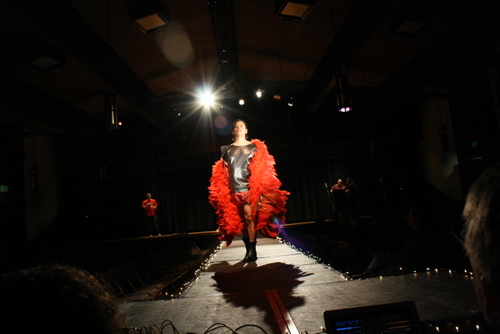Note: This story was originally filed for the Alaska Public Radio Network’s magazine segment, “AK.” Also, KCAW’s Anne Brice attended Friday’s performance and will post a slideshow soon.

Gio Villanueva wears “Icarus Air,” a wearable art piece designed by Megan Johnson. The piece signifies the hubris of the Greek mythological character Icarus, who built wings but flew too close to the sun. (Photo by Ed Ronco/KCAW)
At a fashion show in Sitka, residents have traded in the usual fabrics for more eccentric media. Maybe it’s a dress that’s all zippers. Or a suit made out of nautical charts. Or a purse composed of bicycle valve stems.
In Milan or Paris, this might be called madness. In Sitka, it’s called wearable art.

Chelsey Wheeler and Peter Apathy confer with an artist about music during dress rehearsal at Sitka’s Wearable Arts Show. (Photo by Ed Ronco/KCAW)
Jenn Lawlor sways back and forth, ever so slightly, wearing a big black hoop skirt.
She makes her way down a long runway that extends off the stage at Harrigan Centennial Hall. And when she gets to the end, she takes two rolls of what looks like receipt tape, and puts them on the ground, delicately, on either side of her.
The end of each roll is affixed to her waist and, as she walks back toward the stage it unfurls, stretching the entire length of the runway.
This is dress rehearsal for Sitka’s Wearable Arts Show. And Lawlor is wearing a piece of art called “Stately Dance.” It was designed by Connie LaPerriere. She’s in the hallway after the rehearsal gathering up the tape and stuffing it into a bag.
“It’s recycled paper,” she says. “I used to work at the post office, so it’s what the strips for putting on at the front counter come off of.”
It’s that glossy backing you peel stickers from. Once the tape is unfurled, there’s no way to re-stuff it.
“I have a lot of rolls, I’ve been saving it for sometime,” LaPerriere says. “But the thing is, that was only one quarter of the roll.”

Bill Foster, 74, puts on his wearable art before Wednesday night’s dress rehearsal at the Sitka Wearable Arts Show. The title of Foster’s outfit is “In the Navy,” and is comprised of 13 maritime signal flags attached to a U.S. Navy sailor suit. (Photo by Ed Ronco/KCAW)
On the other side of the building, Bill Foster, 74, is down on one knee tying his shoe in the men’s dressing room.
“I’m the oldest person in the show, I think, today,” he says.
Foster is putting on a sailor suit — the kind they wear in the U.S. Navy. Except sewn onto the pants and top are nautical signal flags.
“Well, I’ve had the flags — there are 40 nautical flags, but I could only get 13 on the suit,” he says. “I hope it works out that I have the longest wearable art entry ever to show you the rest of the 40 flags. You’ll see.”
When it’s his turn to rehearse, Foster makes his way to the stage and appears, suddenly in the arch right at center stage.
“In the Navy,” by the Village People, plays from speakers as onlookers clap. Foster fiddles with something — we can’t quite see it from the auditorium — and then begins to back his way down the runway. As he does, signal flags emerge from the top of his shirt, extending along a string to a hook at the back of the stage.
Bill Foster’s signal flag sailor suit, and all of the pieces here, are called “wearable art.” And organizers, like Jeff Budd, are very emphatic about that term.
“Don’t call it a costume. It’s not a costume,” Budd says. “You can buy a costume. You can get online and you can buy a costume and you can be what’s-his-name from KISS, and you can be Michael Jackson. You can be anybody you want. But in wearable art, you have to make the outfit, and the person is the canvas. Your’e finding some kind of material to put on that person as a canvas. People have taken fish bones, and made them so intricate and woven them into the fabric. People have taken usnea, or old man’s beard, and found ways to press that and do that.”
Wearable Art is not Sitka’s invention. The show here is only in its fifth year. Budd gives credit for “wearable art” to another Southeast community: Ketchikan, where the show is in its 27th year.
Back at the auditorium Foster reels in his flags and dances back upstage to make his exit through the same archway where he entered. This is his third show. Last year, he covered himself in vintage Alaska Airlines baggage tags, and the time before that, he wore license plates and marched to Johnny Cash’s “I’ve Been Everywhere, Man.”
Why does he do it? Why not.































